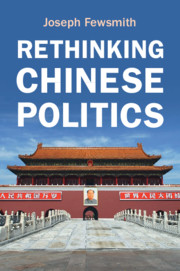Book contents
- Rethinking Chinese Politics
- Rethinking Chinese Politics
- Copyright page
- Dedication
- Contents
- Tables
- Figures
- Acknowledgments
- Abbreviations
- Introduction
- 1 The Dengist Structure of Power
- 2 Succession and the Art of Consolidating Power
- 3 Hu Jintao and the Limits of Institutionalization
- 4 The Pathologies of Reform Leninism
- 5 Xi Jinping’s Centralization of Power
- 6 The Nineteenth Party Congress and Reinvigorating Leninism
- Conclusion
- Bibliography
- Index
1 - The Dengist Structure of Power
Published online by Cambridge University Press: 10 June 2021
- Rethinking Chinese Politics
- Rethinking Chinese Politics
- Copyright page
- Dedication
- Contents
- Tables
- Figures
- Acknowledgments
- Abbreviations
- Introduction
- 1 The Dengist Structure of Power
- 2 Succession and the Art of Consolidating Power
- 3 Hu Jintao and the Limits of Institutionalization
- 4 The Pathologies of Reform Leninism
- 5 Xi Jinping’s Centralization of Power
- 6 The Nineteenth Party Congress and Reinvigorating Leninism
- Conclusion
- Bibliography
- Index
Summary
This chapter examines Deng Xiaoping’s rise to power and his efforts to build a structure that would prevent the return of Maoism. That structure included rejuvenation, the building of leadership groups at different levels, and the introduction of balances. This chapter also discusses the forces that undermined party unity, leading first to the purge of Hu Yaobang and then the Tiananmen events, followed by the ouster of Zhao Ziyang. The military proved to be an important part of Deng Xiaoping’s structure of power. In many ways, Deng tried to introduce institutionalization to correct the concentration of power under Mao Zedong, but Deng’s own dominance of political power contradicted and undermined these efforts to introduce institutionalization.
Keywords
- Type
- Chapter
- Information
- Rethinking Chinese Politics , pp. 24 - 62Publisher: Cambridge University PressPrint publication year: 2021

